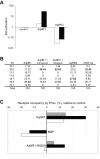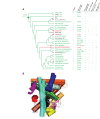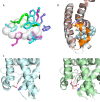Protein evolution by molecular tinkering: diversification of the nuclear receptor superfamily from a ligand-dependent ancestor
- PMID: 20957188
- PMCID: PMC2950128
- DOI: 10.1371/journal.pbio.1000497
Protein evolution by molecular tinkering: diversification of the nuclear receptor superfamily from a ligand-dependent ancestor
Abstract
Understanding how protein structures and functions have diversified is a central goal in molecular evolution. Surveys of very divergent proteins from model organisms, however, are often insufficient to determine the features of ancestral proteins and to reveal the evolutionary events that yielded extant diversity. Here we combine genomic, biochemical, functional, structural, and phylogenetic analyses to reconstruct the early evolution of nuclear receptors (NRs), a diverse superfamily of transcriptional regulators that play key roles in animal development, physiology, and reproduction. By inferring the structure and functions of the ancestral NR, we show--contrary to current belief--that NRs evolved from a ligand-activated ancestral receptor that existed near the base of the Metazoa, with fatty acids as possible ancestral ligands. Evolutionary tinkering with this ancestral structure generated the extraordinary diversity of modern receptors: sensitivity to different ligands evolved because of subtle modifications of the internal cavity, and ligand-independent activation evolved repeatedly because of various mutations that stabilized the active conformation in the absence of ligand. Our findings illustrate how a mechanistic dissection of protein evolution in a phylogenetic context can reveal the deep homology that links apparently "novel" molecular functions to a common ancestral form.
Conflict of interest statement
The authors have declared that no competing interests exist.
Figures






References
-
- Srivastava M, Begovic E, Chapman J, Putnam N. H, Hellsten U, et al. The Trichoplax genome and the nature of placozoans. Nature. 2008;454:955–960. - PubMed
-
- Putnam N. H, Srivastava M, Hellsten U, Dirks B, Chapman J, et al. Sea anemone genome reveals ancestral eumetazoan gene repertoire and genomic organization. Science. 2007;317:86–94. - PubMed
-
- Shubin N, Tabin C, Carroll S. Deep homology and the origins of evolutionary novelty. Nature. 2009;457:818–823. - PubMed
-
- Gronemeyer H, Gustafsson J. A, Laudet V. Principles for modulation of the nuclear receptor superfamily. Nat Rev Drug Discov. 2004;3:950–964. - PubMed
Publication types
MeSH terms
Substances
Grants and funding
LinkOut - more resources
Full Text Sources

